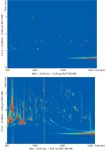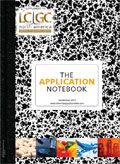Comprehensive Pesticide Residue Monitoring in Foods Using QuEChERS, LC–MS-MS, and GCxGC-TOFMS
One fast, simple QuEChERS extraction for a broad range of pesticides.
- One fast, simple QuEChERS extraction for a broad range of pesticides.
- Rxi®-5Sil MS and Rtx®- 200 column selectivity and orthogonality promote good GC×GC separations.
- Ultra Aqueous C18 LC column retains and gives excellent peak shapes for small polar pesticides.
Pesticide residue analysis of food has traditionally been performed using GC, but there is increasing use of LC with tandem mass spectrometry (MS-MS). LC is favored for polar, less thermally stable, less volatile, compounds. GC–MS is preferred for volatile, thermally stable species, and pesticides that do not ionize well in electrospray or atmospheric pressure chemical ionization LC sources. With MS, complete chromatographic resolution of compounds is not always essential, as selected ions or selected reaction monitoring (SRM) transitions are used for pesticide identification and quantification. However, data quality can be improved through better retention and separation of components, especially for structurally similar pesticides and high-level matrix coextractives. In the work summarized here, we employed a comprehensive approach and analyzed QuEChERS extracts of a variety of foods for pesticides by both GC×GC-TOFMS and LC–MS-MS.

Table I: Results from analysis different brands of supermarket samples
Food commodities were fortified with pesticides and processed using Q-sep™ QuEChERS extraction salts and dSPE tubes. QuEChERS (quick–easy–cheap–effective–rugged–safe) is a sample preparation approach developed by Anastassiades et al. (1) as a simple, rapid, effective, yet inexpensive, way to extract pesticide residues from fruits and vegetables, followed by a dispersive solid phase extraction (dSPE) cleanup of the extract. The foods chosen varied in water, fat, and pigment content, so the ruggedness of QuEChERS as well as the performance of GC×GC-TOFMS and LC–MS-MS could be assessed. Commodities tested were red bell pepper, cucumber, black seedless grape, spinach, lemon, raisin, and hazelnut. In this summary, we report data for grape and lemon, the least complex and most complex of the matrices we assessed. Complete results are available at www.restek.com/comp-pest in the full application note.

Figure 1: GCÃGC-TOFMS contour plots for grape (top) and lemon (bottom) QuEChERS extracts. The lemon extract is much more complex than the grape extract and could not be analyzed by one-dimensional GC.
Column Selectivity and Multidimensional Techniques
We first assessed the complexity of different commodities by examining the total ion chromatogram (TIC) contour plots generated by GC×GC-TOFMS. It is clear from Figure 1 that lemon contains many more coextractives than grape, as demonstrated by the large number of intense (red) signals. While it should be possible to analyze QuEChERS grape extracts for pesticides by one-dimensional GC, multidimensional techniques (e.g., GC×GC–MS, GC–MS-MS, or LC–MS-MS) are necessary for samples as complex as lemon. Column selectivity is an important consideration in multidimensional techniques and the Rxi®-5Sil MS (cat.# 13623) × Rtx®-200 (cat.# 45001) column combination used here provided orthogonal separations that helped isolate target analytes from matrix interferences. Column selectivity is also important in LC–MS-MS methods because coelutions can be problematic if the analytes share MRM transitions. The Ultra Aqueous C18 column (cat.# 9178312) used for this work is both selective for small, polar compounds, showing good retention and peak shape, and has balanced retention for a large number of compounds that vary in physiochemical properties. More balanced retention reduces the number of MRM transitions being monitored at any point in time, and improves data quality by allowing more time to be spent on a smaller number of MRM transitions.

Table II: Percent recovery values for 10 ng/g fortified samples prepared using QuEChERS and analyzed by GCÃGC-TOFMS and LCâMS-MS
Evaluation of a Comprehensive Approach
Good recoveries were obtained for most pesticides in most commodities as determined by both GC×GC-TOFMS and LC–MS-MS. As shown in Table I, quantitative results for grape were excellent, but lemon proved to be a difficult matrix as demonstrated by the fact that 11 pesticides were not detected by LC–MS-MS and two pesticides had interfering compounds when using the GC×GC-TOFMS method. Given lemon's complexity, ion suppression from coelution with coextractives is likely the cause of the undetected compounds in the LC–MS-MS analysis. Similarly, coextracted matrix compounds likely caused the interference that prevented determination of propoxur and terbacil in fortified samples by GC×GC-TOFMS. While recovery results for most pesticides in most commodities demonstrate successful extract cleanup using dSPE, highly complex matrices will benefit from more exhaustive sample cleanup techniques, such as cartridge SPE (2). Incurred residues were also determined and the number of pesticides detected by each technique was comparable. However, there were some pesticides for which residue concentration could only be reported by either GC×GC-TOFMS or LC–MS-MS.
Conclusions
Use of both GC×GC-TOFMS and LC–MS-MS provides more comprehensive results for pesticide residue monitoring in food. The QuEChERS sample preparation approach using Restek Q-sep™ extraction salts and dSPE cleanup tubes worked well for a variety of pesticides and commodities. In general, good recoveries were achieved as determined by both GC×GC-TOFMS and LC–MS-MS. However, more difficult matrices like lemon may benefit from additional cleanup of sample extracts.
Acknowledgments
U.S. Food and Drug Administration/Center for Food Safety and Applied Nutrition; LECO Corporation.
References
(1) M. Anastassiades, S.J. Lehotay, D. Stajnbaher, and F.J. Schenck, J. AOAC International 86, 412 (2003).
(2) J. Cochran, J. Thomas, J. Kowalski, M. Misselwitz, and R.Lake, Determining Pesticides in Dietary Supplements with QuEChERS Extraction, Cartridge SPE, and GCxGC-TOFMS, GNAN1338, Restek Corporation, 2011.
Restek Corporation,
110 Benner Circle, Bellefonte, PA 16823
tel. (800) 356-1688; (814) 353-1300
Website: www.restek.com

Analytical Challenges in Measuring Migration from Food Contact Materials
November 2nd 2015Food contact materials contain low molecular weight additives and processing aids which can migrate into foods leading to trace levels of contamination. Food safety is ensured through regulations, comprising compositional controls and migration limits, which present a significant analytical challenge to the food industry to ensure compliance and demonstrate due diligence. Of the various analytical approaches, LC-MS/MS has proved to be an essential tool in monitoring migration of target compounds into foods, and more sophisticated approaches such as LC-high resolution MS (Orbitrap) are being increasingly used for untargeted analysis to monitor non-intentionally added substances. This podcast will provide an overview to this area, illustrated with various applications showing current approaches being employed.



















